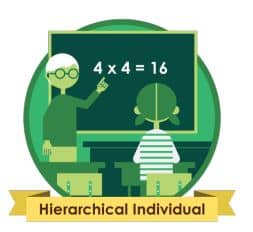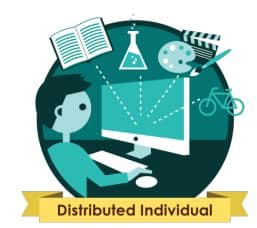This article serves as a summary and notes translated into Spanish of what I consider the Leaders of Learning course bases, from Harvard University, where Professor Elmore proposes 4 learning environments, each with its own design, and divided into several dimensions, which form the quadrant of the 4 Learning Environments.
In addition, this quadrant is also used throughout the course to analyze and study other basic learning competencies, such as learning itself, leadership or organization. Thus, you will be able to find in this blog summaries of the 4 Learning Styles, the 4 Leadership Styles and the 4 Organization Styles proposed on this same scheme.
If these bases serve you, remember that you can assess for yourself whether or not to purchase the complete course at: https://www.edx.org/course/leaders-of-learning
Post content:
Hierarchical Individual Learning Environment:

These design parameters reflect and shape a hierarchical individual learning environment.
Access
- Various students must enter these learning spaces.
- Students are generally organized according to age and ability, as defined by the institution.
Borders and limits
- Distinguish between those who can enter the space and those who cannot.
- Reinforce the role of teachers as experts and students as learners.
Learning places
The institution defines specific places as appropriate for learning. For example, classrooms, led by teachers, using textbooks, blackboards and some digital resources.
Learning transmission
It travels from the teacher to the individual student, and is expressed physically through the seating arrangement (desks, often organized in rows), the position of the teacher at the front of the classroom, and the different classrooms for different subjects.
Hierarchical Collective Learning Environment:

These design parameters reflect and shape a hierarchical collective learning environment.
Access
A variety of students – all committed to the community goals of the organization – need access to this learning space. Members of the broader community, also committed to community goals, need access.
Borders and limits
- Distinguish between those who can enter the learning space and those who cannot.
- Allow entry to community members who support the organization's collective mission.
- Encourage students to engage with the broader community in relation to the organization's learning objectives.
- Reinforce the role of teachers, students and parents as members of the community, with teachers as experts and students as learners.
Places for learning
The institution defines specific places as appropriate for learning. For example, classrooms, led by teachers, but also cultural centers, non-profit organizations, companies and other organizations in the general community.
Learning transmission
It travels from teacher to individual student and from student to student, and is expressed physically through seating arrangements (circles), and other physical options that promote collective work.
Distributed Individual Learning Environment:

These design parameters reflect and shape a distributed individual learning environment.
Access
Both physical and digital spaces must be easy to access and use to maintain student engagement and prevent them from dropping out.
Borders and limits
- Provide students with autonomy to determine their level of engagement and participation in learning.
- The organization of learning determines whether or not interactions between students are part of the official learning experience. However, students have autonomy to create unofficial spaces for communication between students, outside of formally designed learning spaces.
Learning places
- Learning may take place solely in spaces designed by the learning organization or may incorporate other spaces, tools or applications that can facilitate learning.
- The learning organization makes decisions about where learning should take place, but these are always overridden by the actions of the learner.
Learning transmission
- Physical and digital designs must facilitate the transmission of information and knowledge to the individual.
- The individual provides feedback to the learning organization, which can lead to improvements in the design.
Distributed Collective Learning Environment:

These design parameters reflect and shape a distributed collective learning environment.
Access
- It can be restricted to network members or open to the world, or somewhere in between.
- Ease of access and member responsibilities are determined and maintained by network members.
Borders and limits
They allow relationships to form between the network and its environment, the network and the community at large, and sometimes between new members and veterans.
Learning places
Learning may take place solely in the spaces created by the network or may incorporate other spaces, tools or applications that can facilitate learning. This is determined by the network.
Learning transmission
Physical and digital designs facilitate knowledge sharing, learning, operations and network management.
